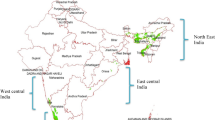Summary
Understanding the biochemical and physiological consequences of species variation would expedite improvement in agronomically useful genotypes of sainfoin (Onobrychis spp.) Information on variation among sainfoin species is lacking on thermal dependence of glutathione reductase (B.C. 1.6.4.2.), which plays an important role in the protection of plants from both high and low temperature stresses by preventing harmful oxidation of enzymes and membranes. Our objective was to investigate the interspecific variation for thermal dependency of glutathione reductase in sainfoin. Large variation among species was found for: (i) the minimum apparent Km (0.4–2.5 μM NADPH), (ii) the temperature at which the minimum apparent Km was observed (15°–5°C), and (iii) the thermal kinetic windows (2°–30°C width) over a 15°–45°C temperature gradient. In general, tetraploid species had narrower (≤17°C) thermal kinetic windows than did diploid species (∼30°C), with one exception among the diploids. Within the tetraploid species, the cultivars of O. viciifolia had a broader thermal kinetic window (≥7°C) than the plant introduction (PI 212241, >2 °C) itself.
Similar content being viewed by others
References
Bingham ET, McCoy TJ (1979) Cultivated alfalfa at the diploid level: Origin, reproductive stability, and yield of seed and forage. Crop Sci 19:97–100
Burke JJ, Mahan JR, Hatfield JL (1988) Crop-specific thermal kinetic windows in relation to wheat and cotton biomass production. Agron J 80:553–556
Connell JP, Mullet JE (1986) Pea chloroplast glutathione reductase: Purification and characterization. Plant Physiol 82:351–356
Cornish-Bowden A (1979) Fundamentals of enzyme kinetics. Butterworths, London
De Kok LJ, Oosterhuis FA (1983) Effects of frost-hardening and salinity on glutathione and sulfhydryl levels and on glutathione reductase activity in spinach leaves. Physiol Plant 58:47–51
Dixon M, Webb EC, Thorne CJ, Tipton KF (1979) Enzymes, 3rd edn. Longman, London
Fyfe JL (1946) Polyploidy in sainfoin. Nature 158:418
Graham D, Patterson BD (1982) Responses of plants to low, nonfreezing temperatures: Proteins, metabolism, and acclimation. Ann Rev Plant Physiol 33:347–372
Guern M, Herve G (1980) Polyploidy and aspartate-transcarbamylase activity in Hippocrepis comosa L. Planta 149:27–33
Habben JE, Volenec JJ (1989) Amylolytic activity in taproots of diploid and tetraploid alfalfa during foliar regrowth. In: Agronomy abstracts. ASA, Madison pp 112
Halliwell B, Foyer CH (1978) Properties and physiological function of a glutathione reductase purified from spinach leaves by affinity chromatography. Planta 139:9–17
Hazel JR, Prosser CL (1974) Molecular mechanism of temperature compensation in poikilotherms. Physiol Rev 54:620–677
Kalt-Torres W, Burke JJ, Anderson JM (1984) Chloroplast glutathione reductase: Purification and properties. Physiol Plant 61:271–278
Kidambi SP, Mahan JR, Matches AG (1990) Purification and thermal dependence of glutathione reductase from leaves of two forage legumes. Plant Physiol 92:363–367
Mahan JR, Burke JJ (1987) Purification and characterization of glutathione reductase from corn mesophyll chloroplasts. Physiol Plant 71:352–358
Mahan JR, Burke JJ, Orzech KA (1987) The thermal kinetic window as an indicator of optimum plant temperature. Plant Physiol Suppl 83:87
Meyers SP, Nichols SL, Baer GR, Molin WT, Schrader LE (1982) Ploidy effects in isogenic populations of alfalfa. I. Ribulose-l,5-bisphosphate carboxylase, soluble protein, chlorophyll, and DNA in leaves. Plant Physiol 70:1704–1709
Patterson BD, Graham D (1987) Temperatures and metabolism. In: Stumpf PK, Conn EE (eds) The biochemistry of plants: a comprehensive treatise. Academic Press, New York, pp 153–199
Pfeiffer T, Schrader LE, Bingham ET (1980) Physiological comparison of isogenic diploid-tetraploid, tetraploid-octoploid alfalfa populations. Crop Sci 20:299–303
Somero GN (1975) Temperature as a selective factor in protein evolution: The adaptational strategy of “compromise”. J Zool 194:175–188
Teeri JA (1980) Adaptation of kinetic properties of enzymes to temperature variability. In: Turner NC, Kramer PJ (eds) Adaptation of plants to water and high temperature stress. Wiley and Sons, New York, pp 251–260
Upchurch DR, Mahan JR (1988) Maintenance of constant leaf temperature by plants. II. Experimental observations in cotton. Env Exp Bot 28:359–366
Author information
Authors and Affiliations
Additional information
Communicated by H. F. Linskens
This work was supported by USDA Specific Cooperative Agreement No. 58-7MN1-8-143 from the Plant Stress and Water Conservation Unit, USDA-ARS, Lubbock, Texas. Joint contribution of Texas Tech University, Lubbock, Texas and the USDA-ARS. TTU Journal No. T-4-291
Rights and permissions
About this article
Cite this article
Kidambi, S.P., Mahan, J.R. & Matches, A.G. Interspecific variation for thermal dependence of glutathione reductase in sainfoin. Theoret. Appl. Genetics 79, 600–604 (1990). https://doi.org/10.1007/BF00226871
Received:
Accepted:
Issue Date:
DOI: https://doi.org/10.1007/BF00226871




